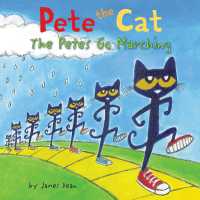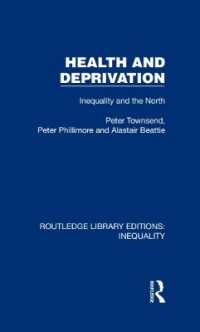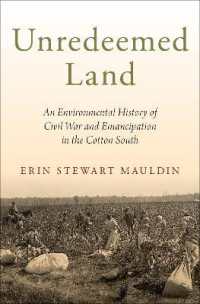基本説明
This is a new and enlarged edition of Ben Rampton's ground breaking study of sociolinguistic processes in urban youth culture.
Full Description
Volume 5
This is a new and enlarged edition of Ben Rampton's ground-breaking study of sociolinguistic processes in urban youth culture. It focuses on language crossing - the use of Panjabi by adolescents of African-Caribbean and Anglo descent, the use of Creole by adolescents with Panjabi and Anglo backgrounds, and the use of stylized Indian English. Its central question is: how far and in what ways do these intricate processes of language sharing and exchange help to overcome race stratification and contribute to a new sense of mixed youth, class and neighbourhood community?
Ben Rampton produces detailed ethnographic and interactional analyses of spontaneous speech data, and integrates the discussion of particular incidents with theories of discourse, code-switching, social movements, resistance and ritual drawn from sociolinguistics, sociology, anthropology and cultural studies. Vivid descriptions of adolescent life in youth clubs and school playgrounds provide an important insight into the ways in which young people manage to 'live with difference', and full consideration is given to crossing's critical implications for education policy.
Contents
Part I: Introductory Chapter 1 Introduction: language, ethnicity and youth in late industrial Britain 1.1 Starting points in sociolinguistics and sociology 1.2 Competing grounds for political solidarity 1.3 Distinctive concerns in the present study 1.4 Descriptive and theoretical concepts 1.5 Siting within sociolinguistics 1.6 Fieldwork, methods and data-base 1.7 The town, neighbourhood and networks 1.3 The chapters that follow Notes Chapter 2 Local reports of language crossing 2.1 Reports of interracial Creole 2.2 Interracial Panjabi 2.3 Comparison of crossing in Panjabi and Creole 2.4 Stylised Asian English 2.5 Comparison of SAE, Panjabi and Creole 2.6 Summary and overview: a local and historical setting for language crossing Notes Part II: Interaction with adults: contesting stratification Chapter 3 Stylised Asian English (i): interactional ritual, symbol and politics 3.1 Linguistic features marking speech as SAE 3.2 Interview reports 3.3 Incidents observed 3.4 Ritual, symbol and politics in interaction 3.5 Interaction and social movements Notes Chapter 4 Panjabi (i): interactional and institutional participation frameworks 4.1 Panjabi in conflictual interaction with adults 4.2 Panjabi crossing in non-conflictual adult-adolescent interaction 4.3 Adult-adolescent participation frameworks in Panjabi and SAE 4.4 Bystanding as a contingent relationship 4.5 The institutional embedding of interactional relations Notes Chapter 5 Creole (i): links to the local vernacular 5.1 Interview reports 5.2 Evidence from interaction 5.3 The correspondence between interactional and institutional organisation 5.4 Interactional evidence of Creole's incorporation with oppositional vernacular discourse 5.5 Creole and the local multiracial vernacular 5.6 Correction by adults 5.7 Summary 5.8 Conclusion to Part 11: crossing, youth subcultures, and the development of political sensibilities Notes Part III: Interaction with peers: negotiating solidarity Chapter 6 Stylised Asian English (ii): rituals of differentiation and consensus 6.1 SAE in criticism 6.2 Critical SAE to adolescents with lower peer group status 6.3 Critical SAE between friends and acquaintances 6.4 SAE in structured games 6.5 Summary: SAE to adults, to adolescents and in games 6.6 Rituals of disorder, differentiation and consensus 6.7 Games Notes Chapter 7 Panjabi (ii): playground agonism, 'language learning' and the liminal 7.1 Panjabi in the multiracial playground repertoire 7.2 Playground Panjabi in games 7.3 Jocular abuse 7.4 Not-so-jocular abuse 7.5 Self-directed playground Panjabi 7.6 Mellowing over time 7.7 Girls and playground Paniabi: cross- and same-sex interactions 7.8 Overview: opportunities, risks and the enunciation of 'tensed unity' 7.9 Language crossing and the 'liminal' Notes Chapter 8 Creole (ii): degrees of ritualisation in Ashmead and South London 8.1 Hewitt's analysis 8.2 Crossing with degrees of ritualisation







